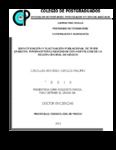| dc.description.abstract | En la actualidad los cultivos de hortalizas en México son severamente afectados por insectos conocidos como trips (Thysanoptera: Insecta), las pérdidas son notables en jitomate, chile, tomate de cáscara, calabacita, pepino y cebolla por la importancia económica que representan. La afectación es, por los daños que ocasionan cuando se alimentan de sus brotes y frutos tiernos, follaje y flores, por la transmisión de virus fitopatógenos, por su periodicidad y por las constantes aplicaciones de productos fitosanitarios para su control. Las especies Frankliniella occidentalis y Thrips tabaci, destacan como las más relevantes en estos cultivos por su capacidad invasiva, su amplia distribución y polifagia. De febrero de 2010 a febrero de 2011 se muestrearon cultivos de jitomate, chile, tomate de cáscara, calabacita, pepino y cebolla en Puebla y Morelos de la región central de México, con el objetivo de determinar las especies presentes, estudiar su fluctuación población y conocer el efecto de las condiciones ambientales de temperatura y precipitación pluvial en la población. Por otro lado durante 2011 y 2012 se realizaron muestreos de la especie Frankliniella occidentalis en cultivos de jitomate, chile, calabacita y pepino de diferentes regiones geográficas de Baja California, Campeche, Chiapas, Chihuahua, Colima, Estado de México, Guanajuato, Jalisco, Morelos, Puebla, Sinaloa y Veracruz para analizar la región ITS2 del ADN ribosomal, con los objetivos de estimar su variabilidad genética dentro y entre poblaciones y conocer su posible historia evolutiva de la población en México. En la región central se determinaron tres especies, Frankliniella occidentalis (Pergande), Frankliniella fortissima(Priesener) y Thrips tabaci (Lindeman). Se determinó que el mayor pico de población coincide con la presencia de flores en todos los cultivos, excepto en cebolla. Se presentaron de dos a seis generaciones por ciclo de cultivo y se observó que las poblaciones disminuyen cuando las plantas se acercan a la senescencia. El mayor efecto negativo sobre la población de trips fue ocasionado por la precipitación pluvial. Por otro lado con el análisis de la región ITS2 del ADN ribosomal de F. occidentalis, se identificó un alto nivel de polimorfismo dentro y entre poblaciones, la reconstrucción de la filogenia y de la historia evolutiva señaló una estructura poblacional asociada con la región geográfica y los hospederos de donde fueron colectados los especímenes. Asimismo se incluyen nuevos cultivos como hospederos de este trips y se indican nuevas áreas de distribución, ampliando así su presencia en México. _______________ IDENTIFICATION AND POPULATION FLUCTUATION OF THRIPS (INSECTA: THYSANOPTERA) ASSOCIATED WITH VEGETABLE CROPS INTHE CENTRAL REGION OF MEXICO. ABSTRACT: Currently, vegetable crops in Mexico are severely affected by insects known as thrips (Thysanoptera: Insecta) with notable losses in tomato, chili pepper, green tomato, zucchini, cucumber, and onion given the economic importance they represent. The effect comes due to the damage caused when they feed on the shoots, young fruits, foliage, and flowers, the transmission of phytopathogenic viruses, their periodicity and the constant application of phytosanitary products for their control. The species Frankliniella occidentalis and Thrips tabaci stand out as the most relevant in these crops due to their invasive capacity, their wide distribution, and polyphagia. From February 2010 to February 2011, samples were taken from zucchini, onion, chili pepper, cucumber, tomato, and green tomato crops in Puebla and Morelos, in the central region of Mexico, with the objective of determining the species present, studying their population fluctuation and knowing the effect of the environmental conditions pertaining to temperature and rainfall on their populations. Moreover, during 2011 and 2012, samplings of the species F. occidentalis were taken from tomato, chili pepper, zucchini, and cucumber crops from different geographical regions of Baja California, Campeche, Chiapas, Chihuahua, Colima, the State of Mexico, Guanajuato, Jalisco, Morelos, Puebla, Sinaloa, and Veracruz to analyze the ITS2 region of ribosomal DNA with the objectives of estimating its genetic variability within and among populations, and learning the possible evolution history of the population in Mexico. Three species were determined in the Central Region: Frankliniella occidentalis (Pergande), Frankliniella fortissima (Priesener), and Thrips tabaci (Lindeman). It was determined that the highest population peak coincides with the presence of flowers in all crops, with the exception of onions. There were from two to six generations per crop cycle, and it was observed that the populations decrease when the plants near senescence. The greatest negative effect on the populations was caused by rainfall. With the analysis of the ITS2 region of the rDNA of F. occidentalis, a high degree of polymorphism was identified within and among populations. The reconstruction of the phylogeny and the evolution history points to a population structure associated with the geographical region and the hosts from which they were collected. Likewise, new crops are included as hosts for this thrips, and new areas are indicated, thus widening their presence in Mexico. | en_US |

